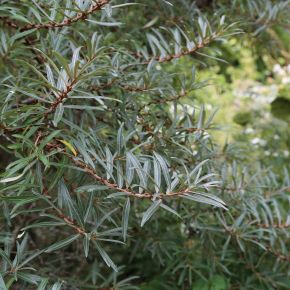Hippophae rhamnoides
(Sea Buckthorn)
Family - Elaeagnaceae
Category - Shrub
Origin - Europe, Asia
Year of Introduction - 1245
Season of Interest - Spring, Summer, Autumn, Winter
Hardiness - H7
Height - up to 6m
Width - 3m or more
Location - The White Garden
Description: A large Deciduous Shrub or small tree with an upright, bushy habit, though the overall size can be controlled by pruning. Slender grey-green to silvery-green leaves are linear to lanceolate in shape. This plant is Dioecious (male and female flowers are held on separate plants). The flowers are small, yellowish-green and held in Racemes on female plants and in catkins on male plants. The Blooms are produced in mid-spring as the foliage emerges. The flowers on female plants (if pollinated by a nearby male) will be followed by round orange berries that will be retained on the plant through most of the winter. The berries are not well-liked by birds, but are very high in vitamin C.
Additional common name - Sallow Thorn
Flower:
Dioecious. Small flowers are greenish-yellow and held in racemes on female plants and catkins on male plants. The flowers are produced with the emerging leaves in April. Round, orange berries are produced on female plants and are retained on the plant through the winter. Both male and female specimens are required for berries to be produced. The berries are very sour and not well-liked by birds, but are very high in vitamin C.
Flower colour: Yellow-green
Flower shape: Racemes or catkins
Flowering time: April
Foliage:
Slender grey-green to silvery-green leaves are linear to lanceolate in shape. The leaves are Alternately arranged on the branches.
Foliage Senescence: Deciduous
Foliage Shape: Linear to lanceolate
Propagation:
Cuttings, seed.
Cultivation:
Best in full sun in moisture-retentive soil that is well-drained.

